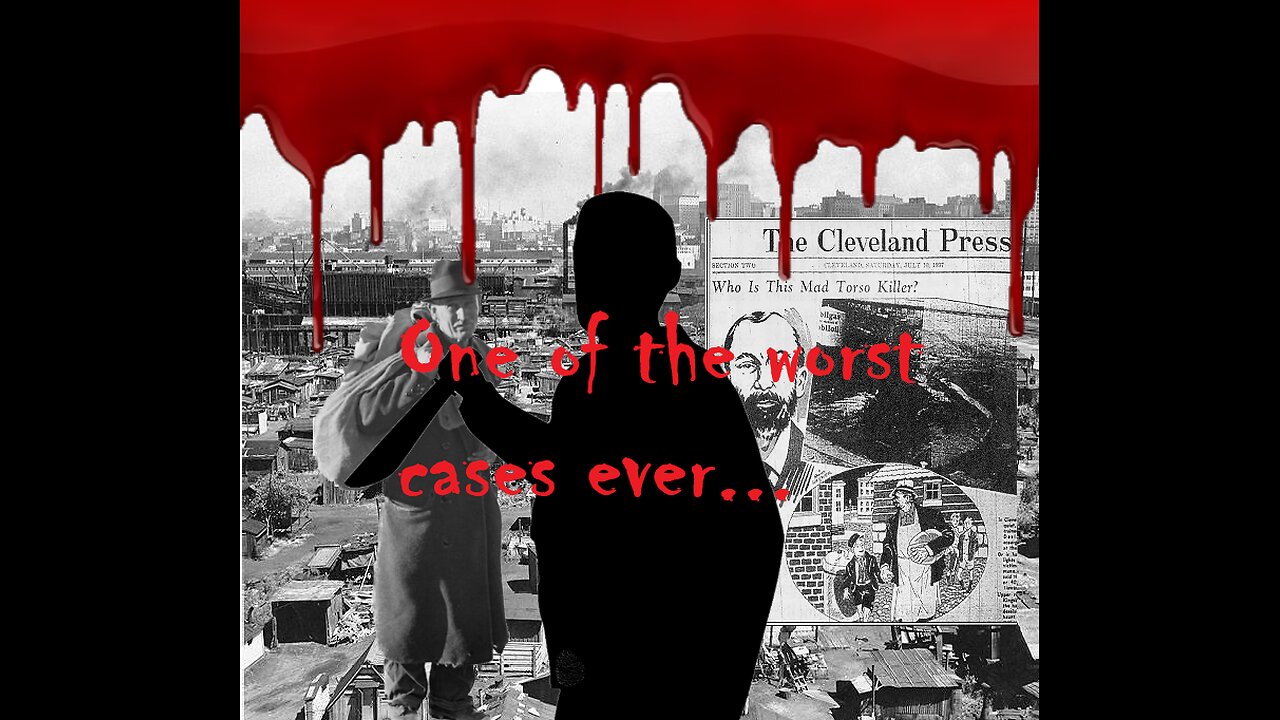Premium Only Content

UNSOLVED: The Mad Butcher of Kingsbury Run #truecrime
In the mid to late 1930s a monster lurked in Cleveland Ohio. This twisted creature did not stop at simply taking lives, but would dismantle the victims leaving the parts to be found in a neighborhood called Kingsbury run. There were at least 13 men and women who fell prey to this unidentified evil with many more suspected to be related to this case. The horrific things that were done to the bodies led these crimes to captivate and terrify even to this day. The victims heads were removed and in some cases never found and their bodies were cut into pieces leading to the ominous nickname given to the monster by the press. Despite advances in forensic technology, many of the victims have never been identified. This is compounded by the fact that the area where these events occurred was occupied by homeless and vulnerable people. Due to the amount of time that has passed it is unlikely that police will ever identify the Mad Butcher of Kingsbury Run.
Hit that like button, it’s free then drop a comment on what case you’d like to see next.
During the 1920’s or the roaring 20’s as they are sometimes called, Cleveland was a growing city. Immigrants were coming to fill the manufacturing and industrial jobs that made up the city’s economy. Within the city, wealthy individuals sponsored educational and cultural development and the future looked bright. Then came the stock market crash of 1929.
Along with the market crash, there was the smoot-hawley tariff which passed in 1930 that crippled international trade in an attempt as protecting American industry. As things started to collapse, many people tried to pull their money out of failing banks which accelerated the damage to the economy as banks began to fail. The bank runs would lead to the creation of the FDIC in 1933 which protects individuals accounts up to a certain dollar amount even if the bank they are held at fails.
Amidst all this, the people were suffering as their money dried up and jobs disappeared. To make matters worse, a series of dust storms ravaged farmlands and creating the dust bowl. Suffice to say, the 1930s were a rough time to be alive. But things for the residents of Cleveland were about to get worse as a series of horrific crimes came to light in the Kingsbury Run neighborhood.
The area had become a hobo jungle or shanty town during the great depression. With the unemployment level reaching as high as 24.9%, these neighborhoods of shacks began popping up as desperate families put together makeshift shelters to weather the economic turmoil. Kingsbury run was an especially good location as there were train tracks that ran through it offering transportation to those willing to jump a freight train.
On one end of the run, shady operators saw a source of income as we see in poverty stricken neighborhoods today and opened bars, brothels, gambling houses, and flophouses which were essentially super cheap hotels with apalling conditions. The neighborhood already had a bad reputation for crime and violence, but a year into the Great Depression a different sort of crime would overshadow everything and terrify the city.
The first body was found on September 5 1934. A woman’s torso was discovered on the shore of Lake Erie. The head arms and upper torso had been removed and the legs were cut off at the knee. Subsequent searches for her head were not successful, though addiontal body parts were reported to have been seen in the water.
Because this victim was never identified, she was nicknamed the lady of the lake, a reference to the legend of King Arthur. There was little for investigators to go on. She had a surgery scar from a hysterectomy, which was common at the time, otherwise there was nothing aside from the chemical lime chloride that had been put on the skin. Likely this was an attempt to accelerate decomposition, but it instead preserved the remains making the skin leathery and tough.
While the lady of the lake has not been definitively connected to the other homicides in this series, the similarities make it extremely likely. The body was found in nearly the exact same place as a later victim who also had the same chemical applied to her skin.
Just over a year after the lady of the lake was found another body surfaced. Edward Anthony Andrassy was a 29 year old man who had spent some time working at a asylum but was unemployed at the time he lost his life. His remains were found in a ditch along East 49th street on the edge of Kingsbury run.
Andrassy’s head had been removed and buried near his body and his wrists had rope burns where he had been restrained. An autopsy determined that he had been dead for 2 to 3 days prior to being discovered. Nearby another body was found. But like the lady of the lake, this victim remains unidentified. Once again the head had been removed and it appeared as though someone had tried to set the body on fire.
On January 26th 1936, the remains of a woman were discovered wrapped in newspaper and loaded into baskets. The baskets were found left next to the Hart manufacturing company. But not all of the body was found until February 7th, when the rest of the woman was found excluding the head in a vacant lot nearby.
Using fingerprints, investigators were able to identify the woman as 44 year old Florence Genevieve Polillo, who had worked as a waitress and some reports also have her working as a lady of the night at the time she lost her life to the deranged monster lurking in Cleveland. She was last seen in a neighborhood bar.
6 months later another body was found, this time near the east 55th street bridge on June 5 1936.
While the name of this victim is unknown, he would he remebered as the tattooed man due to a handful of them on his body, he had a cartoon character called Jiggs on his left calf, an anchor and Cupid on the right calf, a woman’s name and dove on his right arm, a butterfly on the right shoulder, flags and a heart with an arrow through it on his left arm. These tattoos were recreated and presented them to the public on an effort to get an Id.
The body was stripped nude and his head was found near some train tracks. Due to the lack of blood at either of the 2 scenes, investigators concluded that he had been mutilated elsewhere and then dumped there post Mortem. The only clue to the culprit was a Cadillac seen near the dump sites the night before the body was discovered.
An autopsy revealed that the tattooed man had been alive when he was decapitated and there was no evidence of restraints, drugs, or alcohol in his system which is odd as it begs the question how someone was able to do such a horrific thing to a person without them fighting back or trying to flee.
The next John Doe is as found on July 22 1936 near a homeless camp in Big Creek, just outside of Cleveland by a teenager. He had also been decapitated and left to decompose, with his head being no more than a skull found nearby. The level of decay would make fingerprinting and therefore identification impossible and missing persons reports were of no help.
This would be the only known victim to be found away from Kingsbury Run, however the marge amount of dried blood in the area points to this being where his life was taken and possible where the other victims had met their ends as well prior to being dumped by Lake Erie. It was estimated that the remains had been out in the elements for at least 2 months.
Like so many of these cases, the only thing investigators knew was that the victim was a person down on their luck, in this case the man was a homeless drifter around 40 years old suspected of riding in and out of town on the passing freight trains.
In the fall of 1936 the coroner would arrange a meeting with the police and other specialists in what the papers referred to as the “Torso clinic.” The goal was to see if they could put their heads together to review the case and see if together they could figure something about the elusive killer. Police had begun walking the streets dressed as transients to see if they could draw out the perpetrator.
The Mad Butcher was not done for the year with the pace of the crimes leading one to wonder if during the pause between the early homicides, whether the creature was simply operating in another location. In September a man going to hop a train on east 37th street stumbled over a torso and a pair of legs was found floating in a nearby open sewer.
It was around this time that famed lawman Elliot Ness became involved in the case. ness had risen to fame with his team of untouchables and their investigation into Al Capone. An autopsy found some troubling details about the latest body found in Kingsbury Run. The coroner found that the head had been removed expertly in one quick stroke in very specific locations to cut through the joints rather than cutting through the solid bone.
The lack of miscuts showed that the culprit had practiced what he was doing and was comfortable committing these heinous acts and knowledgable of the human body. The victim was a man in his mid 20s who had lost his life when his head was removed. In this case he had also had his manly parts sliced off.
On February 23 1937, the upper half of a woman’s torso was found on the shore of Lake Erie in almost exactly the same location as where the lady of the lake had been found. The unknown woman was white and around 25 to 30 years old. 3 months later, the lower half of the torso was found washed to shore. But the head, arms, and legs were never found.
This case stands out from the rest for 2 primary reasons. First there were multiple small cuts or hesitation cuts instead of the sure and efficient strokes on prior victims.
#unsolved unsolved #crime crime #serialkiller
Serial killer
#cleveland
#horror #evil
-
 1:23:41
1:23:41
Game On!
1 day ago $11.31 earnedNetflix NFL Christmas Games Preview and Predictions!
70.2K9 -
 2:05:07
2:05:07
Darkhorse Podcast
1 day agoWhy Trump Wants Greenland: The 257th Evolutionary Lens with Bret Weinstein and Heather Heying
299K583 -
 8:50:58
8:50:58
Right Side Broadcasting Network
1 day ago🎅 LIVE: Tracking Santa on Christmas Eve 2024 NORAD Santa Tracker 🎅
379K56 -
 2:48
2:48
Steven Crowder
1 day agoCROWDER CLASSICS: What’s This? | Nightmare Before Kwanzaa (Nightmare Before Christmas Parody)
340K13 -
 33:49
33:49
Quite Frankly
1 day agoThe Christmas Eve Midnight Telethon
134K22 -
 2:12:46
2:12:46
Price of Reason
1 day agoAmber Heard BACKS Blake Lively Lawsuit Against Justin Baldoni! Is Disney CEO Bob Iger in TROUBLE?
81.4K24 -
 1:01:17
1:01:17
The StoneZONE with Roger Stone
23 hours agoChristmas Edition: Why the Panama Canal is Part of the America First Agenda | The StoneZONE
150K52 -
 18:12:15
18:12:15
LFA TV
1 day agoLFA TV CHRISTMAS EVE REPLAY
159K19 -
 13:32
13:32
Scammer Payback
1 day agoChanging the Scammer's Desktop Background to his Location
25.5K6 -
 4:21
4:21
BIG NEM
1 day agoNikola Tesla's Secret to Cultivating Creativity & Genius
19.8K1